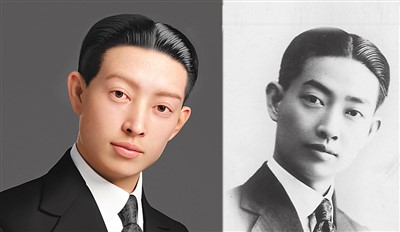Digital humans become new 'messengers' of traditional Chinese culture
With the development of technologies, including information technology and artificial intelligence (AI), digital humans have become the new "messengers" of traditional Chinese culture.
A digital human is an avatar of a human being that exists in the digital world, according to Bao Yuanfu, an associate professor at the College of Media of Guizhou Minzu University in southwest China's Guizhou Province.
Before Chinese New Year leapt into 2022, the Year of the Tiger, a video of an AI-powered virtual replica of Peking Opera master Mei Lanfang (1894-1961) sending New Year greetings went viral, receiving 50 million views.

Photo shows a picture of the virtual replica of Peking Opera master Mei Lanfang (Photo courtesy of the interviewee)
From face, posture and tone, to clothing and props, all the details revolving around Mei were digitized and visualized.
Digital Mei made its debut in 2021, as "he" walked towards the center of the stage at a gentle pace at Beijing’s Mei Lanfang Theatre.
The late Mei was a world-renowned Chinese artist of Peking Opera who made prominent contributions to the improvement and popularization of the art form.
The Central Academy of Drama (CAD) in Beijing and Beijing Institute of Technology (BIT) jointly launched a project to create an interactive "digital Mei Lanfang," hoping to facilitate the spread of traditional Chinese culture.

The left part of this combo photo shows a picture of the virtual replica of Peking Opera master Mei Lanfang, while the right part shows a picture of Mei. (Photo courtesy of the interviewee)
"I hoped to do something to inject new vitality into Peking Opera I liked," recalled Song Zhen, a professor at CAD who is in charge of the project.
It was very difficult to digitize the deceased due to the lack of high-definition footage of him.
"We gathered relevant historical photos of Mei and invited Zhang Wei, a professor from the Central Academy of Fine Arts, to create a portrait sculpture based on the pictures. We then scanned it with a high-precision laser scanner to secure Mei's digital facial structure," said Weng Dongdong, a researcher at BIT.
The team found a Peking Opera artist who could imitate Mei, collected data including his facial expressions and movements, and "transplanted" that data to the digital image of Mei, Weng added.
Various technologies, including AI, were applied to create the digital version of Mei, said Song. For instance, the research team used AI to recreate the digital Mei's voice through emulation, laying the foundation for future interactive performances of digital Mei.

Photo shows pictures of Peking Opera master Mei Lanfang used for digital modeling of him, and a portrait sculpture based on the pictures. (Photo courtesy of the interviewee)
"From a technical perspective, digital humans involve the use of technologies such as computer graphics, computer vision, intelligent speech, and natural language processing. However, technology alone is not enough. Digital humans must be based on culture," said Weng.
Some digital humans are inspired by traditional Chinese culture. For example, Tianyu is a digital avatar inspired by the Flying Apsaras, the celestial singers and dancers of the Mogao Grottoes' murals in Dunhuang, northwest China's Gansu Province, and female figurines from the Tang Dynasty (618-907). The hairstyle, hairpins, and makeup of Tianyu are based on historical data. Female figurines from the dynasty unearthed in Turpan, northwest China's Xinjiang Uygur Autonomous Region, are behind Tianyu's fetching beauty.
Digital humans can become carriers of Chinese culture, as profound Chinese culture lays a solid cultural foundation for the innovative development of digital humans, said Liu Guiru, an associate research fellow at the Institute of Literature of the Fujian Academy of Social Sciences.
Song believes that the innovative application of digital humans helps promote cultural digitalization. "Our wish is to create more digital versions of iconic figures of traditional Chinese culture and national spirit by leveraging advanced technologies including AI, to showcase the brilliant Chinese culture," Song said.
"Creating more diverse Chinese-style digital humans to enable them to reach overseas audiences through films, TV series, dramas, literature, art, games and cartoons help extend the reach and appeal of Chinese culture," said Bao.
Photos
Related Stories
- Pic story: inheritor of traditional string-weaving technique in NE China's Jilin
- Going digital for going popular -- Tech empowers traditional Chinese culture
- Young artist dedicated to passing down the craft of tongcao flowers making
- People greet Longtaitou Day across China
- Chinese time-honored brands take on new look
- Feature: Chicago Field Museum hosts Chinese Culture Day
Copyright © 2023 People's Daily Online. All Rights Reserved.









